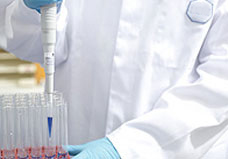|
What is myopathy?
Myopathies are diseases of skeletal muscle which are not caused by
nerve disorders. These diseases cause the skeletal or voluntary
muscles to become weak or wasted. Myopathies are usually
degenerative, but they are sometimes caused by drug side effects,
chemical poisoning, or a chronic disorder of the immune system.
Among their many functions, genes are responsible for overseeing
the production of proteins important in maintaining healthy cells.
Muscle cells produce
thousands of proteins. With each of the inherited myopathies, a
genetic defect is linked to a lack of, or problem with, one of the
proteins needed for normal muscle cell function.
There are many different types of myopathies, some of which are
inherited, some inflammatory, and some caused by endocrine
problems. Myopathies are rare and not usually fatal. Typically,
effects are mild, largely causing muscle weakness and movement
problems, and many are transitory. Only rarely will patients
become dependent on a wheelchair. However, muscular dystrophy
(which is technically a form of myopathy) is far more severe. Some
types of this disease are fatal in early adulthood. Genetic
myopathies include central core disease, centronuclear (myotubular)
myopathy, myotonia congenita, nemaline myopathy, paramyotonia
congenita, periodic paralysis and mitochondrial myopathies. These
forms vary by symptoms, severity and genetic mutation. Both
dominant and recessive modes of inheritance are also present.
Certain forms of centronuclear myopathy, also known as myotubular
myopathy, have been found to be X-linked and primarily affects
males.
Congenital myopathies are a heterogeneous group of disorders that
cause hypotonia in infancy or weakness and delayed motor
milestones later in childhood. An autosomal dominant form of
nemaline myopathy is linked to chromosome 1 (-tropomyosin gene),
and a recessive form to chromosome 2. Other forms are caused by
mutations in the gene for the ryanodine receptor (the calcium
release channel of the sarcoplasmic reticulum) on chromosome 19q.
Skeletal abnormalities and dysmorphic features are common.
Diagnosis is made by histochemical and electron microscopic
examination of a muscle sample to identify specific morphologic
changes. Congenital muscular dystrophy (CMD) is evident at birth
and causes general muscle weakness and joint deformities. Central
core disease is a slowly progressing skeletal muscle disorder
that, unlike most of the muscular dystrophies, is not
life-threatening. Myotonia congenital, also known as Thomsen's
disease, is a nonprogressive muscle disorder that develops from
infancy to childhood. Paramyotonia congenital, also known as
Eulenberg's disease, is evident at birth, and like myotonia
congenita, is characterized by stiff muscles that take a long time
to relax after contraction, it is not progressive, and it does not
cause muscle weakening. Myotubular myopathy, also known as
centronuclear myopathy, is a slowly progressive disease that
causes drooping of the eyelids, foot drop, facial weakness, and
other muscle weakness. Nemaline myopathy, also known as Rod body
disease, develops from birth to adulthood and is nonprogressive
and usually not fatal.
Mitochondrial myopathies range from mild, slowly progressive
weakness of the extraocular muscles to severe, fatal infantile
myopathies and multisystem encephalomyopathies. Some syndromes
have been defined, with some overlap between them. Established
syndromes affecting muscle include progressive external
ophthalmoplegia, the Kearns-Sayre syndrome (with ophthalmoplegia,
pigmentary retinopathy, cardiac conduction defects, cerebellar
ataxia, and sensorineural deafness), the MELAS syndrome
(mitochondrial encephalomyopathy, lactic acidosis, and stroke-like
episodes), the MERFF syndrome (myoclonic epilepsy and ragged red
fibers), limb-girdle distribution weakness, and infantile myopathy
(benign or severe and fatal).
In some cases, myopathies can be caused by a malfunctioning gland
(or glands), which produces either too much or too little of the
chemical messengers called hormones. Hormones are carried by the
blood and one of their many functions is to regulate muscle
activity. Problems in producing hormones can lead to muscle
weakness. Hyperthyroid myopathy and hypothyroid myopathy affect
different muscles in different ways. Hyperthyroid myopathy occurs
when the thyroid gland produces too much thyroxine, leading to
muscle weakness, some muscle wasting in hips and shoulders, and,
sometimes, problems with eye muscles. The hypothyroid type occurs
when too little hormone is produced, leading to stiffness, cramps,
and weakness of arm and leg muscles.
Some myopathies are inflammatory, leading to inflamed, weakened
muscles. Inflammation is a protective response of injured tissues
characterized by redness, increased heat, swelling, and/or pain in
the affected area. Examples of this type include polymyositis,
dermatomyositis, and myositis ossificans. Dermatomyositis is a
disease of the connective tissue that also involves weak, tender,
inflamed muscles. In fact, muscle tissue loss may be so severe
that the person may be unable to walk. Skin inflammation is also
present. The cause is unknown, but viral infection and antibiotics
are associated with the condition. In some cases, dermatomyositis
is associated with rheumatologic disease or cancer. Polymyositis
involves inflammation of many muscles usually accompanied by
deformity, swelling, sleeplessness, pain, sweating, and tension.
It, too, may be associated with cancer. Myositis ossificans is a
rare inherited disease in which muscle tissue is replaced by bone,
beginning in childhood.
Metabolic myopathies are characterized by the absence of a
substance that is essential for normal muscle function and are
associated with genetic defects. In many of these disorders, the
symptoms increase after exercise, and a person may experience
severe muscle pain during exercise. This is usually due to a lack
of oxygen and the absence of the chemicals necessary for
maintaining the energy level of the muscle. There are numerous
metabolic myopathies. McArdle's disease results from a genetic
defect that causes phosphorylase deficiency. It usually develops
in adolescence and is characterized by cramps after exercise, and
sometimes muscle weakening. Most people can avoid progression of
the disease by avoiding strenuous exercise, although about
one-third of all people with McArdle's disease eventually have
permanent muscle weakness. Phosphofructokinase deficiency, also
known as Tarui's disease, is also caused by a genetic defect.
Symptoms include cramping after exercise and sometimes muscle
weakness. Carnitine palmityltransferase deficiency causes muscle
tissue breakdown and pain. An inherited autosomal recessive
genetic mutation is implicated. This condition appears to be more
common in men than women.
While considered to be a separate group of diseases, the muscular
dystrophies also technically involve muscle wasting and can be
described as myopathies. These relatively rare diseases appear
during childhood and adolescence, and are caused by muscle
destruction or degeneration. They are a group of genetic disorders
caused by problems in the production of key proteins. Duchenne
muscular dystrophy (DMD) is caused by a defective recessive gene
on the X chromosome and occurs only in boys. On average, one in
three cases results from a new genetic mutation in the mother or
grandmother and has not been passed down from generation to
generation for very long.Becker muscular dystrophy (BMD) resembles
DMD the muscles are affected in much the same way, and it can
cause heart complications but it develops during adolescence or
adulthood, not early childhood. Emery-Dreifuss muscular dystrophy
(EDMD) is a slowly progressing disease that affects children and
young teenagers. Limb-girdle muscular dystrophy (LGMD) is a slowly
progressing weakening of the shoulder and pelvis muscles that
onsets anywhere from childhood to middle age. Myotonic dystrophy
is also known as Steinart's disease. It is a slowly progressing
disease that onsets anytime from childhood through middle age.
Oculopharyngeal muscular dystrophy (OPMD) is a slowly progressing
disease that first affects the eyelid and throat muscles and
causes swallowing difficulties. Distal muscular dystrophy is a
slow progressive weakening of the hands, forearms, and lower legs.
|





